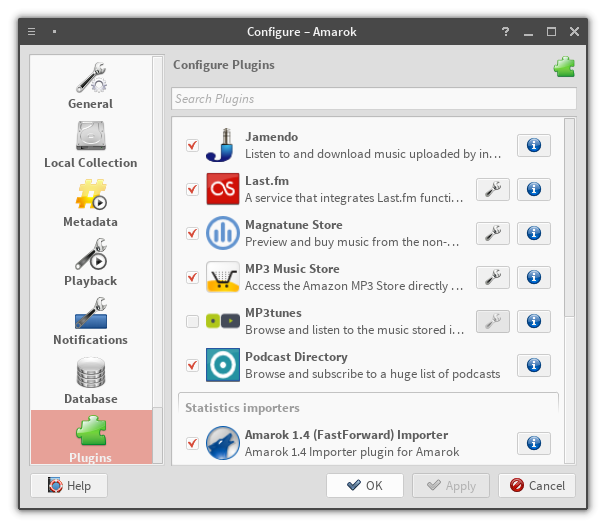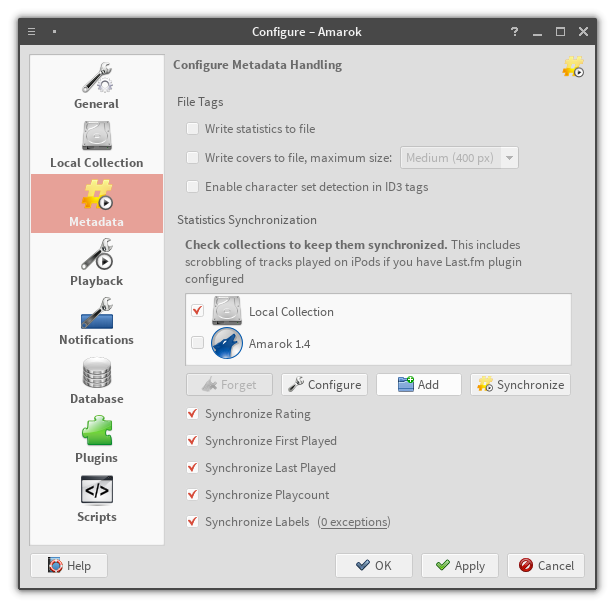GSoC Status Update - Week 4
15 Jul 2013This is a status update for my Google Summer of Code 2013 project - implementing advanced statistics importers for Amarok. Please read the first post if you would like to know more about the project.
Let me clear some things out first. Scheduled: "Reimplementing FastForward importer. At the end of the week I expect to have a functional importer, possibly with some quirks to iron out. Implementing unit tests to assert correctness." Done: I could argue the former; the Amarok 1.4 importer does work, with some quirks to iron out. The latter? Tests are untouched.
Yet this was by far the most intensive week of coding so far, and the task I focused on is the hardest part - the most important part - of the whole project. First, to give some context, let's talk about how I design programming frameworks.
How do I do it
I'm not much of a fan of the waterfall model. All of its other shortcomings aside, I need to see how things actually work together, what is the overall feel of the system. Designing by gut feeling may seem strange, but I'm sure that many programmers will know what I'm talking about here; sometimes a particular mechanism just feels awkward, particular responsibility ill-placed, method redundant. This "methodology" is probably described and named, somewhere. It's something like "incremental development meets rapid prototyping."
I start with a very rough draft of the system, and implement it using empty classes, stubs, etc. (I like when things compile.) Then I pick a component - maybe a single class, maybe a small family - and flesh it out. During this process, I invariably become aware of multiple problems with the sketch, so I rework it to address them. Then I pick another component, and the process repeats. On each iteration I end up with a better design, and it can be vastly different from the previous one.
The moral here is: as not every component is done yet, the system that I wrote may undergo major changes, and definitely will undergo minor-ish ones. So, on to the actual design!
The actual design
A picture is worth a thousand words, so here's a simple class diagram (please
note that only some associations are displayed; e.g. in reality Controller has
some kind of association with most of shown classes). I wrote this diagram
using PlantUML - give it a look!

First, importers are now plugins. That means that they need to be registered with the plugin framework (using a semi-convenient macro), and they need to provide a .desktop file containing some meta-information. On the flip side we get automatic loading, which can be turned on and off at user's leisure.

The plugin infrastructure takes care of instantiating and initializing
Plugins::PluginFactory class, which in case of importers is a subclass of
ImporterFactory, which in turn is a subclass of ProviderFactory. The
ImporterFactory and ImporterProvider classes are serving only as a common
base for importers, to reduce boilerplate code and duplication - all of the
relevant interface methods are specified in ProviderFactory.
The ProviderFactory contains, among others, methods returning: icon, name,
description, and configuration widget for that particular provider type. The
configuration widget is of type ProviderConfigWidget, which is an interface
with one method: config(), returning a QVariantMap populated with values set
by user. The returned QVariantMap is in turn used by another method of
ProviderFactory, createProvider( const QVariantMap &config ).

I've also extended StatSyncing::Provider with two methods:
ProviderConfigWidget *configWidget(), which returns a configuration widget for
this provider instance, if any; and bool isConfigurable(), which returns
true if provider is configurable. The reason for this is to enable
reconfiguration of importers, and putting it in a base class makes sense (in
future it could be used for Last.fm provider, for instance). The implementer of
StatSyncing::Provider is responsible for reconfiguring the provider instance
after the configuration is done. The question of how he will know that it's
done will be answered later, but reconfiguring can be done in much the same way
that initial configuration is done.

As I mentioned, ImporterProvider and ImporterFactory serve to reduce
boilerplate. They have some sane defaults which greatly reduce amount of code
needed to implement new providers, and I hope to reduce it yet further. For
starters, ImporterProvider by default delegates queries for description, icon,
configuration widget, to corresponding ImporterFactory. That means many
attributes need only be set in the ImporterFactory subclass, and not in the
Provider, and it will just work. While the reconfiguration part is not yet
programmed in, it will be done automatically by the framework; the same
ProviderConfigWidget will be used, prepopulated by ImporterFactory. The
factory will then create new provider using the modified config, and
transparently swap it with the old provider, immutable-style.
Current status
What works
- FastForward Provider
- registering plugins
- provider creation dialog, complete with creating new provider
- loading up configuration at startup
What doesn't
- saving configuration at shutdown
- reconfiguring provider
- forgetting provider
- dialogs being pretty - there's a reason for the lack of configuration dialogs' screenshots
- FastForward Provider - the tracks are found but displayed as unique, even though the metadata seems identical
Plans for the future
Obviously my schedule is now a bit skewed, as by now I was supposed to finish up FastForward Provider complete with tests, and start implementing iTunes Provider. Right now the plan is to finish up the importers framework, so everything that's needed is usable - doesn't have to be perfect yet. If things will go as I anticipate, implementing iTunes Provider should be a breeze, and creating every subsequent provider even easier.
As always, you can check out my progress on my public Amarok clone. The branch
is named gsoc-importers.
Thanks for reading!